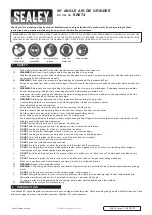
-4-
Mfg. Since 6/10
Model SB1044
I N S T R U C T I O N S
Maintenance
When you replace the old cutting fluid, take the
time to thoroughly clean out both sides of the
tank. Make sure to dispose all old fluid according
to local regulations. Cutting fluid is considered
hazardous waste by the EPA. Follow all disposal
and storage guidelines when changing and
disposing of cutting fluid.
Tip:
Maintaining the specific gravity of cutting
fluid with a hydrometer or refractometer can
greatly extend the life of cutting fluid and
reduce operating costs. Properly maintained
cutting fluid allows for better cutting and longer
grinding wheel life.
Items Needed:
Qty
New Pre-Mixed Cutting Fluid ................ 9 Gallons
Safety Goggles .......................................................1
Rubber Gloves ...............................................1-Pair
Wrench 28mm .......................................................1
5-Gallon Bucket w/Lid ..........................................2
Hex Wrench 3mm .................................................1
Hot Soapy Water or Mineral Spirits .... As Needed
Waste Coolant Drain Hose ................... As Needed
Cotton Rags ........................................... As Needed
Mineral Spirits ...................................... As Needed
Magnets .................................................... Optional
To change the cutting fluid:
1.
Remove the four button head screws and
washers from the tank cover.
2.
Open the tank cover so the cutting fluid can
be seen.
3.
Fasten the waste coolant drain hose to
the coolant nozzle. If the connection is
questionable, use a hose clamp to ensure it
does not leak.
4.
Place the other end of the drain hose into one
of the 5-gallon buckets. Clip or wire the hose
in place so it won’t come out of the bucket
when the pump is turned ON.
5.
Open the flow lever on your cutting-fluid
nozzle all the way open, and turn the cutting
fluid pump ON. Do not leave the area as
you will need transfer the hose to the other
bucket to prevent over-filling and spills.
Leaving the pump running with an empty
cutting fluid tank can damage a pump. Shut
the pump OFF immediately when the fluid
slows or stops coming from the drain hose.
6.
When the fluid stops flowing, immediately
turn the pump OFF, and disconnect the
drain hose.
7.
Disconnect the machine from power, lift the
pump and cover from the tank, and set it
aside for cleaning and inspection.
8.
Remove the drain plug, and pour the
remaining cutting fluid from the tank into
the 5-gallon bucket.
9.
Seal the buckets with their lids.
10.
Mark or tag the buckets as hazardous waste
(according laws and regulations).
11.
Using a solution of soapy hot water and rags,
clean and dry the tank, the pump, and the
cover. If the tank residue is oily, clean with
mineral spirits instead of soapy water.
Tip:
Place one or more strong magnets at the
bottom of the tank to collect fine metal
particles from the cutting fluid.
12.
Reinstall the drain plug.
13.
Mix the new cutting fluid with water in
the required ratio until the fluid reaches
the specific gravity indicated by the fluid
manufacturer.
14.
Pour the cutting fluid into the tank. To
prevent the pump from running dry, never
use less than four gallons of cutting fluid.
15.
Point the cutting fluid nozzle into the coolant
trough and open the valve.
16.
Turn the machine and pump ON to verify
that fluid cycles properly, then turn it OFF.


























